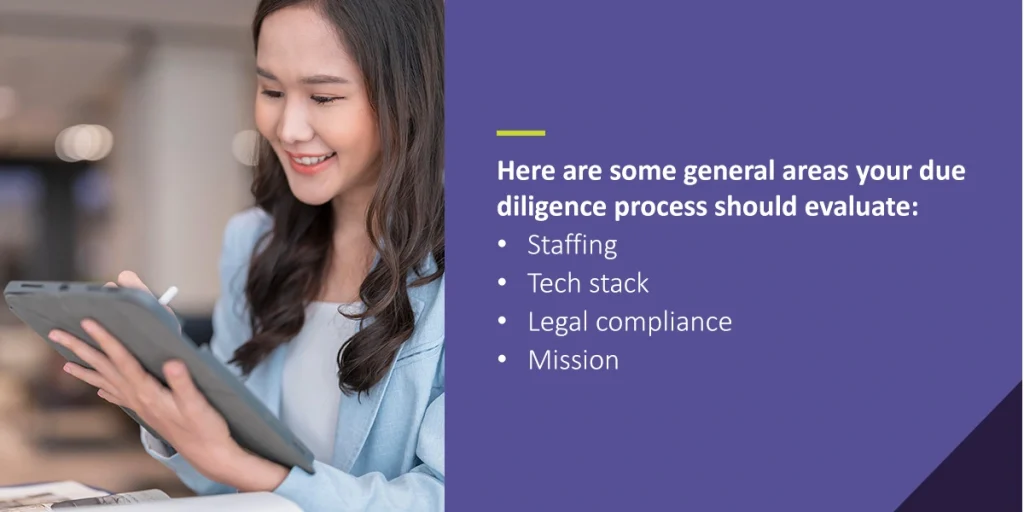



American higher education is undergoing enormous changes right now. Thanks to a perfect storm of declining enrollment and rising costs, merger and acquisition (M&A) activity has tripled among institutions of higher education over the past decade.
Given the benefits of educational M&As, that trend is projected to continue well into the future. Partnerships between institutions can help expand program offerings, reduce costs and tuition, and streamline internal operations — which can all help to attract more students.
The thing is, M&A is just as challenging in higher ed as it is in any other industry. Performing due diligence on every aspect of an institution — including the technology it uses — is vital for justifying your investment.
Tech due diligence involves conducting a comprehensive audit of an institution’s technology ecosystem to understand:
Performing technology due diligence is a critical step in negotiating any type of higher ed partnership, but it’s especially important in a full M&A. First and foremost, it helps the solvent institution determine whether its target institution is a good match by providing a detailed understanding of the target institution’s administration and technology setup.
It helps reduce the risk of investing by identifying potential red flags, if any exist. It can also help uncover hidden opportunities to create value for students and faculty, which can help give your institution a competitive advantage.
Internally, tech due diligence enables an institution to identify areas for improvement. Whether you’re preparing for an M&A or your institution is growing in some other way, you can gain valuable insights into the health of your tech ecosystem — which is essential for maintaining stakeholder engagement.
Depending on the size and complexity of the institution you’re evaluating, the due diligence process could take anywhere from a few weeks to a few months.
Having a due diligence checklist can help get you started. Here’s a simple product roadmap you can use to define your due diligence process.
Both parties should take some time before beginning due diligence to ensure their institutions are well-prepared.
Specifically, the institution under evaluation should prepare relevant documentation and make sure there are no information gaps. Missing documentation can delay or even halt the process entirely, so it’s important to ensure everything is in order before beginning the investigation.
Transparency is key when preparing your documentation. Maximize the deal’s chances of success by disclosing all critical information about your institution upfront — the more everyone knows at the outset, the more likely you will be to close the deal.
This step is essential for making sure everyone is on the same page. In it, you’ll learn all the major information you need to know about the acquisition whether you’re on the buy-side or the sell-side.
Although the specific requirements will vary depending on the scope of the acquisition, there are a few items that apply to every merger. Here are some general areas your due diligence process should evaluate:

Finally, the scope of your due diligence will depend on the target institution’s size and maturity. A small private liberal arts college, for example, will likely be a less intensive project than a large public university simply because it has fewer tech resources to evaluate.
Begin the audit by examining all the provided documentation, including all legal and business contracts, financial reports, procurement and operations information, and whatever other information that could be relevant to the investigation.
During this stage, you’ll also want to investigate the tech stack itself. Examine items like code quality, architecture, backups, and integrations to see whether each tool fulfills its purpose — and to confirm whether it is compatible with your existing system.
After assessing all provided documentation, the prospective buyer’s team should hold one-on-one meetings with key members of the target institution’s IT team. These interviews will provide vital insights into the institution’s internal processes, which is essential for identifying inefficiencies and other potential red flags.
Some questions you should ask include:
Thoroughly document everything you learn throughout the audit, as you will need to provide this information to your stakeholders in your final report.
At this stage, you can usually perform a preliminary analysis of the data you’ve collected to check your progress. If you believe there to be gaps in your findings, you can take this time to conduct additional tests and reviews.
Once you’ve gathered and analyzed all the necessary data, it’s time to compile your audit report. This document should clearly summarize all your findings in a way that demonstrates your understanding of:
Based on your final report, you can determine whether your acquisition is the right choice for your institution.
Higher education institutions have a unique responsibility to ensure their tech stack directly serves their mission of preparing students for the future. Whether merging with another institution as part of a growth plan or simply adding to their digital infrastructure, thoroughly researching technical tools is critical in making a sound investment.
At Watermark, we strive to help educational institutions successfully navigate the rapidly changing landscape of higher education. Our software solutions help administrators enhance both student and faculty experiences by streamlining internal operations and providing room to scale.
Contact us today to request a free demo of our industry-leading educational software.






























































































































































































































































































































































































